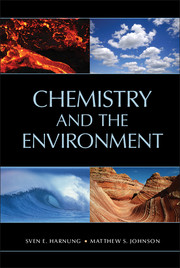Book contents
- Frontmatter
- Contents
- Preface
- Acknowledgments
- Chemistry and the Environment
- Introduction
- 1 The Earth
- 2 Environmental dynamics
- 3 The Spheres
- 4 Chemistry of the atmosphere
- 5 Chemistry of the hydrosphere
- 6 Chemistry of the pedosphere
- 7 Global cycles of the elements
- 8 The chemicals industry
- 9 Environmental impact of selected chemicals
- 10 The chemistry of climate change
- Appendix 1
- Appendix 2
- Appendix 3
- Appendix 4
- Appendix 5
- References
- Name index
- Subject index
- Miscellaneous Endmatter
- References
3 - The Spheres
Published online by Cambridge University Press: 05 November 2012
- Frontmatter
- Contents
- Preface
- Acknowledgments
- Chemistry and the Environment
- Introduction
- 1 The Earth
- 2 Environmental dynamics
- 3 The Spheres
- 4 Chemistry of the atmosphere
- 5 Chemistry of the hydrosphere
- 6 Chemistry of the pedosphere
- 7 Global cycles of the elements
- 8 The chemicals industry
- 9 Environmental impact of selected chemicals
- 10 The chemistry of climate change
- Appendix 1
- Appendix 2
- Appendix 3
- Appendix 4
- Appendix 5
- References
- Name index
- Subject index
- Miscellaneous Endmatter
- References
Summary
It seems “natural” to describe the Earth in terms of spherical shells, given the shape of the planet and its layered structure. The atmosphere is a good example of such a shell. This chapter begins by introducing some basic ideas and continues with a more thorough discussion, including the chemical structure and composition of the spheres, along with some key features of the physics of each sphere and their interactions.
From a chemical perspective, the Earth has a distinct central region, called the barysphere, on which the lithosphere, the hydrosphere, and the atmosphere rest. The term sphere is used in a more abstract sense than the simple meaning of “ball”; for example, the hydrosphere, comprising all states of aggregation of water, is irregular in form and extent. In the context of the environment, it is convenient to discuss separately the pedosphere, which consists of the material in which plants grow, and to delimit the biosphere as follows later.
Suess (1875) was the first to attempt to unite the fields of geophysics and biology. His contribution was to recognize and characterize the biosphere as the region that gives rise to life. The concept was refined by Vernadsky (1925) to mean the top part of the lithosphere, part of the hydrosphere, and thetroposphere, the lowest layer of the atmosphere. According to his definition, the biosphere is the part of the Earth that sustains life, but not including biota, defined as living and dead organisms. Today, biosphere is understood to mean all organic material and that part of the inorganic surroundings in which life is found. It has been proposed that the word ecosphere be used with this meaning, in contrast to biosphere,whichwould then be used to mean all living and dead organisms and their degradation products; however, these definitions have not been widely accepted. The part of the Earth that is not the biosphere is called the geosphere.
- Type
- Chapter
- Information
- Chemistry and the Environment , pp. 98 - 139Publisher: Cambridge University PressPrint publication year: 2012



